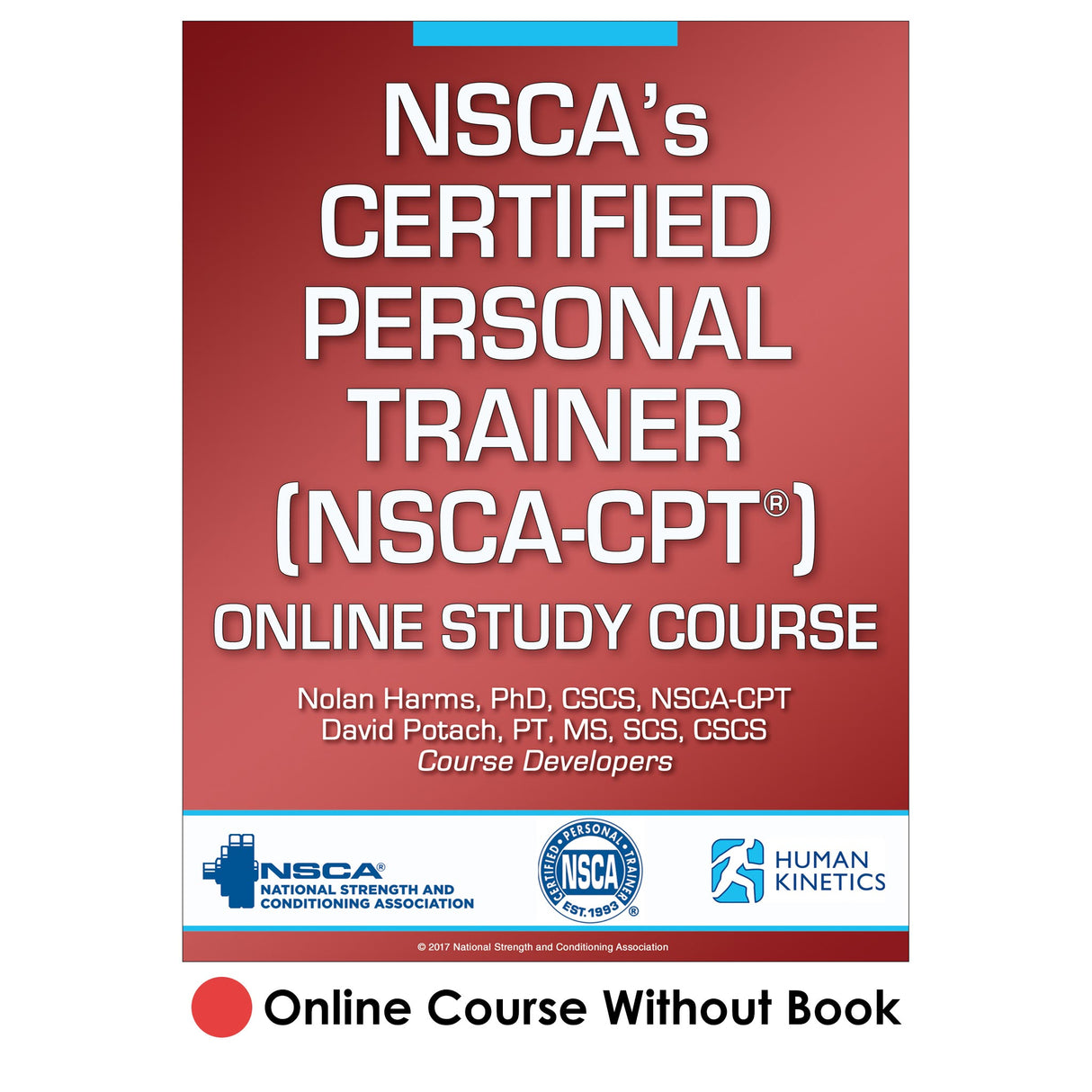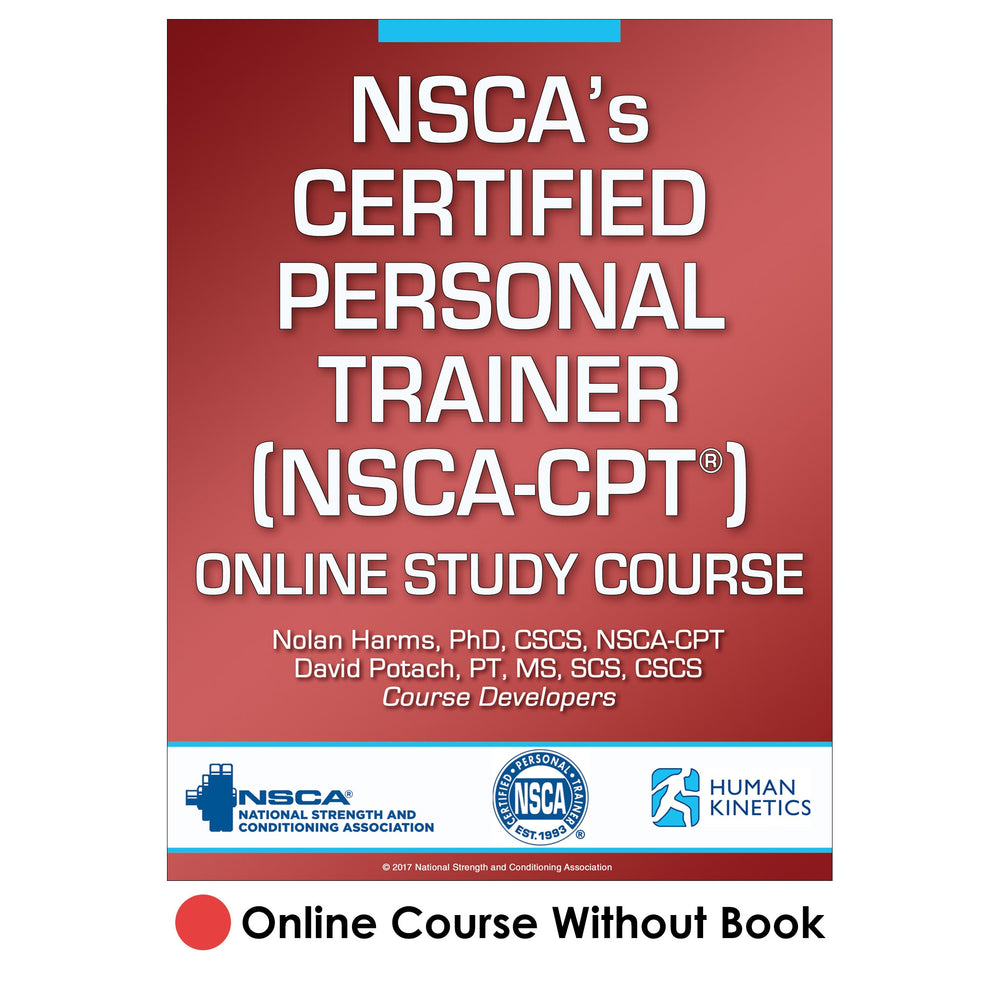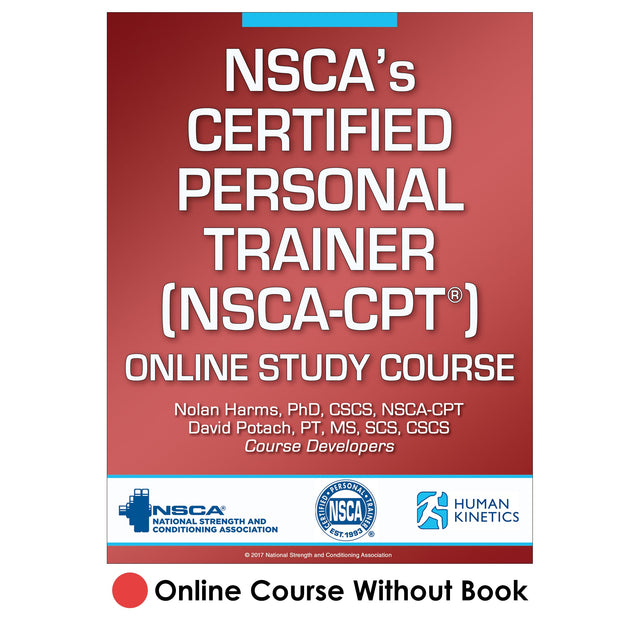NSCA’s Certified Personal Trainer (NSCA-CPT) 3rd Edition Online Study/CE Course Without Book
$199.00 USD
Human Kinetics strongly recommends that you complete your exam within the calendar year of your date of purchase to ensure approved credits do not expire for your organization.
This package includes:
- Online course activities
- Online continuing education exam
Certified personal trainers are fitness professionals who use an individualized approach to assess, motivate, educate, and train clients to help them achieve their health and fitness goals. The NSCA-CPT certification is widely recognized as an esteemed credential for personal training professionals in the United States and increasingly around the world. The National Strength and Conditioning Association and Human Kinetics have jointly developed an online course to help candidates study for the NSCA-CPT examination. NSCA’s Certified Personal Trainer (NSCA-CPT) Online Study/CE Course works in tandem with the material presented in NSCA’s Essentials of Personal Training to offer a practical and efficient method of studying the content assessed on the NSCA-CPT exam.
The course content reflects the weighting and scope of the NSCA-CPT exam and has varying levels of recall, application, and analysis learning activities for each primary objective. Featuring over 120 interactive learning activities, this online course offers scientific knowledge and practical application and pinpoints the information required for preparing for the exam. The content covered relates directly to the on-the-job duties and responsibilities of a certified personal trainer, and an end-of-course test evaluates the learner’s content knowledge, mimicking the scope and difficulty of the actual certification exam. Current certified professionals who complete the course and pass the test can earn continuing education units.
The information presented in the course assists exam candidates in the studying process. It should not be considered the only method of preparing for the NSCA-CPT exam. Ultimately, each candidate’s academic, practical, and test-taking abilities will dictate the effectiveness of the preparation materials. The information should increase the likelihood of passing the NSCA-CPT exam, but it does not guarantee a successful performance.
Course Objectives
See Table of Contents tab.
Unit 1. Initial Interview
- Determine compatibility between a client and a personal trainer.
- Complete an agreement between client and personal trainer or an agreement between client, personal trainer, and fitness facility.
- Administer an informed consent and release of liability form.
Unit 2. Medical History and Health Appraisal
- Administer a detailed medical history and health appraisal form and a lifestyle questionnaire (including exercise history) and, if necessary, obtain a medical release from the client’s primary physician.
- Evaluate and interpret medical history and health appraisal form and lifestyle questionnaire.
- Recognize when to refer a client to or seek input from an appropriate health care professional.
Unit 3. Fitness Evaluation
- Conduct a fitness evaluation.
- Evaluate and interpret the results of a health and fitness evaluation.
- Recognize when to refer a client to and/or seek input from an appropriate health care professional.
Unit 4. Basic Nutrition Review
- Identify the personal trainer’s scope of practice regarding nutrition recommendations.
- Conduct a review of a client’s dietary habits (e.g., recall, history, or food records).
- Communicate basic information regarding daily caloric needs.
- Recognize the signs and symptoms of an eating disorder.
- Recognize when to refer a client to or seek input from an appropriate health care professional.
Part 2. Program Planning
Unit 5. Goal Setting
- Discuss the results of a fitness evaluation with a client to determine needs and goals.
- Discuss results of dietary habit review with a client to determine needs and goals.
- Discuss health-related lifestyle habits (smoking, alcohol use, etc.) with a client to determine needs and goals.
- Determine the motivational and coaching techniques that will be effective for a client.
Unit 6. Program Design
- Select the exercise modality or type.
- Determine exercise frequency.
- Determine the order of exercises or exercise components.
- Determine the exercise intensity.
- Determine exercise volume (including sets and repetitions) and duration.
- Determine rest interval length and work-to-rest ratios.
- Determine the rate of exercise progression.
- Understand periodization concepts and applications.
- Select the warm-up and cool-down activities of a training session.
Unit 7. Training Adaptations
- Explain exercise-induced changes to body structures.
- Describe exercise-induced changes to body systems.
Unit 8. Special Populations
- Determine capacities and limitations of a client with a special need or condition.
- Modify the exercise program to coincide with the limitations and capacities of a client with a special need or condition.
- Recognize when to refer a client or seek input from an appropriate health care professional.
Part 3. Techniques of Exercise
Unit 9. Machine Resistance Exercises
- Instruct a client on proper exercise technique for machine resistance exercises.
- Correct a client’s improper exercise technique for machine resistance exercises.
Unit 10. Free Weight Exercises
- Instruct a client on proper exercise technique for free-weight exercises.
- Correct a client’s improper exercise technique for free-weight exercises.
- Describe and teach effective spotting procedures and techniques.
Unit 11. Other Exercises
- Instruct a client on proper exercise technique for functional training exercises.
- Correct a client’s improper exercise technique for functional training exercises.
- Instruct a client on proper exercise technique for calisthenic and body-weight exercises.
- Correct a client’s improper exercise technique for calisthenic and body-weight exercises.
- Instruct a client on proper exercise technique for sport-specific and performance-related activities
- Correct a client’s improper exercise technique for sport-specific and performance-related activities.
- Instruct a client on proper exercise technique for cardiorespiratory machine and nonmachine activities.
- Correct a client’s improper exercise technique for cardiorespiratory machine and nonmachine activities.
Part 4. Safety, Emergency Procedures, and Legal Issues
Unit 12. Safety Procedures
- Properly monitor and maintain exercise equipment.
- Create a safe exercise environment according to industry standards.
- Recognize symptoms related to overtraining, overuse injuries, and temperature-induced illness.
Unit 13. Professional, Legal, and Ethical Responsibility
- Recognize litigation issues and circumstances.
- Maintain a professional client–personal trainer relationship.
- Maintain client–personal trainer confidentiality.





